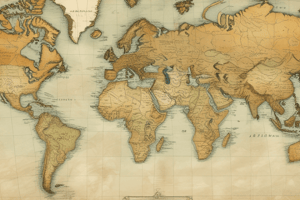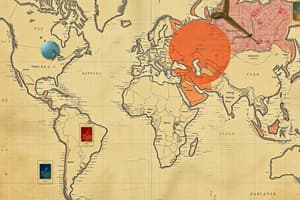Podcast
Questions and Answers
What is a primary factor contributing to population increase in a given region?
What is a primary factor contributing to population increase in a given region?
- Lack of medical facilities
- Poor education
- Emigration
- Improvements in agriculture (correct)
Which of the following is NOT a push factor contributing to urbanisation?
Which of the following is NOT a push factor contributing to urbanisation?
- Natural disasters
- Lack of entertainment
- Better education (correct)
- Poor medical services
What is the primary outcome of urbanisation?
What is the primary outcome of urbanisation?
- Decreased population in urban areas
- Increased population in rural areas
- Increase in the number of people living in urban areas (correct)
- No change in population distribution
Which of the following is a factor responsible for population decrease?
Which of the following is a factor responsible for population decrease?
What is the role of inoculation in population growth?
What is the role of inoculation in population growth?
What is the relationship between education and population growth?
What is the relationship between education and population growth?
What is the primary cause of urbanisation?
What is the primary cause of urbanisation?
Which of the following is a pull factor contributing to urbanisation?
Which of the following is a pull factor contributing to urbanisation?
What is the effect of better medical technology on population growth?
What is the effect of better medical technology on population growth?
What is the role of immigration in population growth?
What is the role of immigration in population growth?
Flashcards are hidden until you start studying
Study Notes
Map Skills
- Ratio scale: expresses distance using numbers (e.g., 1:100,000)
- Line scale: consists of a line divided into primary units to the right and secondary units to the left of zero
- Calculating distance on a map:
- Formula: distance on map × scale of map / 100,000 (for kilometers)
- Formula: distance on map × scale of map / 100 (for meters)
Water Cycle
- Dew point: temperature at which condensation starts
- Condensation: process of water changing from gas to solid
- Phases of water cycle:
- Evaporation from lakes, rivers, and trees
- Condensation in the atmosphere
- Formation of clouds
- Precipitation (rain)
Climatic Regions South of the Sahara
- Equatorial rainforest
- Tropical savannah
- Tropical desert
- Factors influencing dew and frost:
- Dew: occurs during summer, formed when water vapor reaches dew point temperature
- Frost: occurs during winter, formed when dew point is below freezing point
Ancient Egypt
- Development of Egyptian kingdom began around 3100 BC, influenced by the Nile River
- People became farmers, specialized in different activities, and formed a kingdom
Sustainable Utilization of Resources
- Non-renewable resources: cannot be replaced by nature (e.g., minerals, fossil fuels)
- Importance of sustainable utilization:
- Minerals: implement water conservation practices, reduce mining waste
- Fossil fuels: reduce energy consumption, use alternative energy sources
Population Growth and Change
- Factors affecting population growth:
- Birth rate, immigration, better medical technology, improvements in agriculture
- Factors affecting population decrease:
- Death rate, emigration, education
- Urbanization: process of people moving from rural to urban areas, leading to population growth in cities
Urbanization
- Causes of urbanization:
- Push factors (e.g., lack of jobs, poor services in rural areas)
- Pull factors (e.g., better jobs, education, and services in urban areas)
- Problems of urbanization:
- Overcrowding, poor living conditions, lack of services
Studying That Suits You
Use AI to generate personalized quizzes and flashcards to suit your learning preferences.




